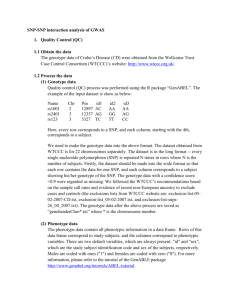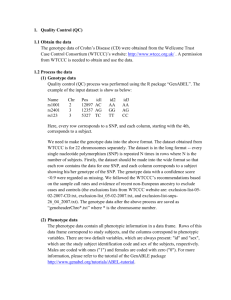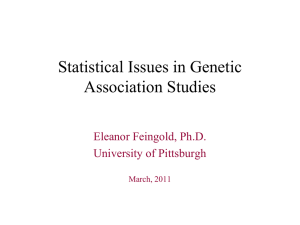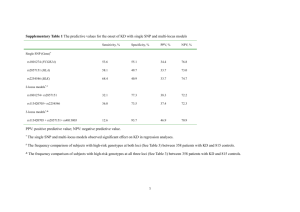Figure S1. - Genome Biology
advertisement
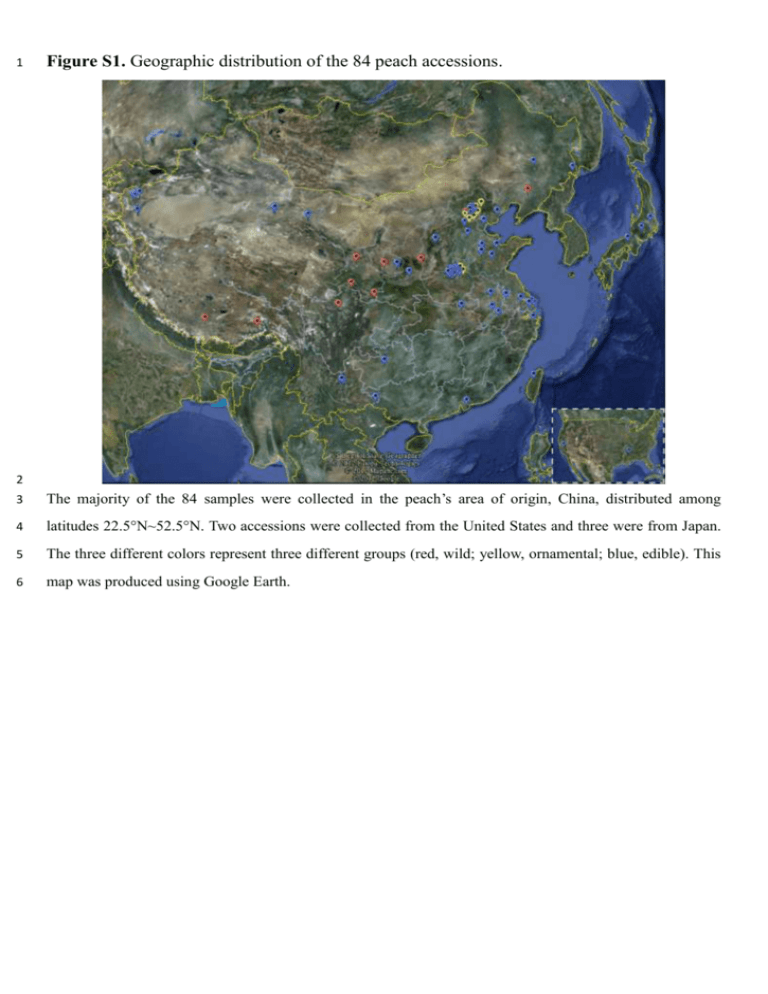
1 Figure S1. Geographic distribution of the 84 peach accessions. 2 3 The majority of the 84 samples were collected in the peach’s area of origin, China, distributed among 4 latitudes 22.5°N~52.5°N. Two accessions were collected from the United States and three were from Japan. 5 The three different colors represent three different groups (red, wild; yellow, ornamental; blue, edible). This 6 map was produced using Google Earth. 7 Figure S2. Relationship between the identified single-nucleotide polymorphisms (SNPs) and 8 the sample sizes. 9 10 We analyzed the relationship between the identified SNPs in the genotype and the sample sizes in each 11 group (statistics from Scaffold 8). We found that the increase in the sample size in wild lines greatly aided 12 the identification of SNPs. However, the rate of increase slowed for sample sizes > 8. The contributions 13 from cultivated lines such as ornamental, landrace, and breeding lines were weak, but these lines contained 14 many ecotypes and various phenotypes. Considering that a sufficient number of SNPs and phenotypes 15 existed in different lines and in three main groups (wild, ornamental, and edible), we concluded that the 16 sample sizes of 10, 9, 42, and 23 in wild, ornamental, landrace, and breeding lines, respectively, were 17 suitable. 18 Figure S3. Relationship between the called single-nucleotide polymorphisms (SNPs) and the 19 sequencing depth. The called SNPs of L11/Whole genotype 100% 90% 88.0% 80% 93.2% 90.7% 92.2% 82.9% 70% 72.7% 60% 50% 50.7% 40% 30% 20% 10% 0% 0 1 2 3 4 5 6 7 8 9 10 Sequencing depth (X) 20 21 We performed sequencing of two samples (L11 and B65) to the 7× depth and used stepped-up reads with 22 different depths (1×, 2×, 3×…) to call SNPs to analyze the relationship between the called SNPs and the 23 sequencing depth. The Y-axis is the ratio of the called SNPs in sample L11 vs. the whole genotype, which 24 contained 84 samples; the X-axis is the sequencing depth of the reads in sample L11 from 1× to 7×. The 25 graph shows the growth trend of the called SNPs with as sequencing depth increases; the ratio of called 26 SNPs vs. the whole genotype reached 82.9% by a depth of 3×, after which growth slowed down. 27 28 Figure S4. Total depth of all genotype sites according to single-nucleotide polymorphisms 29 (SNPs) in the 84 samples. 30 31 We performed a statistical analysis of the total depth of all genotype sites (or called population SNPs) in the 32 84 samples. The pick depth was around 250× (~3× × 84 = 252×). Although some sites from some samples 33 were missing, the total depth of the sites was still high enough to conduct population SNP calling. 34 Figure S5. Single-nucleotide polymorphism (SNP) depth in each sample (L09, L13, W18, 35 and L34). 36 37 We performed statistical analysis of the SNP depth in each sample. These graphs display the SNP depth 38 distributions of heterozygous and homozygous sites in four samples (L09, L13, W18, and L34). The four 39 samples had different average depths in the genome (L09: 3.13×, L13: 3.25×, W18: 2.87×, L34: 5.74×). 40 However, the SNP depth of the heterozygous and homozygous sites differed from the average depth in the 41 whole genome. The peak SNP depth (2~4×) of homozygous sites was a little smaller than the average depth 42 in whole genome, whereas the peak SNP depth (4~6×) of heterozygous sites was a little higher than the 43 average depth in the whole genome. 44 45 Figure S6. Details of the mapping results in single-nucleotide polymorphism (SNP) sites. 46 47 48 49 50 51 52 53 54 55 56 57 58 59 60 61 62 63 64 65 66 67 68 69 70 71 72 73 74 75 76 77 78 79 80 81 82 83 84 85 86 87 88 89 90 91 92 93 a. 94 These figures present the details of the mapping results in homozygous and heterozygous SNP sites. All the 95 reads used for SNP calling were unique mapping reads that could map only once at one location in the 96 genome. For homozygous SNPs (a), sometimes the mapping depth was as low as 2×, but the mapping reads 97 had very high quality values in the SNP sites. For heterozygous SNPs (b), the actual mapping depths were 98 much higher than expected; the majority of them were 4×, 5×, 6×, or higher). These findings provided 99 significant guarantees of the quality of our results of SNP calling. Examples of homozygous SNPs: Sample: B69, SNP position: Scaffold 2 (2,014,579 bp) Reference Genotype Mapping Reads (bases) Reference Genotype Mapping Reads (Quality values) Sample: L11, SNP position: Scaffold 2 (2,014,579 bp) Reference Genotype Mapping Reads (bases) Reference Genotype Mapping Reads (Quality values) b. Example of heterozygous SNP: Sample: O62, SNP position: Scaffold 4 (5,063,466 bp) Reference Genotype Mapping Reads (bases) Reference Genotype Mapping Reads (Quality values) 100 Figure S7. Single-nucleotide polymorphism (SNP) depth distributions of samples without 101 SNPs in repeat regions or homologous sequences. a. Without SNPs in repeat regions: b. Without SNPs in repeat regions or homologous sequences: 102 (a) We filtered the SNPs in repeat regions and recalculated the statistics. The central peaks of the SNP depth 103 of heterozygous sites were around 4~6×, and the central peaks of the SNP depth of homozygous sites were 104 around 2~4×. (b) We filtered the SNPs in repeat regions and in homologous sequences and recalculated the 105 statistics. The distributions were similar; the homologous sequences we defined here comprised the two or 106 more sequences of the reference genome that were the same for the majority of the sequences and had only a 107 few different bases (fewer than 5%). 108 Figure S8. Depth of homozygosis (n = 0) and 109 heterozygosis sites (n > 0) in the genotype. 110 In the total genotype of 84 samples, not all the sites in all samples 111 were 112 homozygotes or data were missing, so we called them homozygosis 113 sites (n = 0); some sites contained heterozygotes in at least one sample, 114 and we called them heterozygosis sites (n > 0). Here “n” was the 115 number of samples with heterozygotes in the site. As shown in the 116 figure, sites with higher heterozygote frequency in the population also 117 had higher total depth. 118 119 homozygous or heterozygous. Some sites contained 120 Figure S9. Two supposed models for explaining why the depth of heterozygous SNP sites 121 was higher than the depth of homozygous SNP sites. 122 123 124 The model 1 is old thought or previous understanding, the model 2 is our interpretation or hypothesis. We 125 believe that both of the models should exist in actual sequencing process. Model 2 could be the reason why 126 the depth of heterozygous SNP sites was higher than the depth of homozygous SNP sites. 127 128 129 130 131 132 133 134 135 136 137 138 139 140 Figure S10. Relationship between missed genotype ratio and sequencing depth in 141 heterozygotes and homozygotes by data fitting. 142 In general, if sequencing depth was higher, the 143 missed genotype (SNPs) would be lower. In 144 order to find the relationship between missed 145 genotype ratio and the sequencing depth, we 146 chose simulated data from Figure 2 of Vieira et 147 al. [12] (shown here), and made a Logistic Fit 148 by OriginLab. 149 Figure (a) was the fitting result of the missed 150 genotype ratio in heterozygotes and the depth. 151 The Input data 1 were chosen and delineated 152 in the red box (heterozygotes, Prior = HWE, 153 True F = 0.00). The best-fitting mathematical 154 relationship between miscalled genotypes in 155 heterozygotes (y) and the depth (x) is 156 y = −0.03786 + 0.60738 + 0.03786 1 + (x/2.76705)1.83427 157 158 159 Figure (b) was the fitting result of the 160 missed genotype ratio in homozygotes and 161 the depth. Input data 2 were chosen and 162 delineated in the blue box (Homozygotes, 163 Prior = HWE, True F = 0.00). The best-fitting 164 mathematical relationship between miscalled 165 genotypes in homozygotes (y) and the depth 166 (x) is 167 y = −0.00717 + 0.34824 + 0.00717 1 + (x/1.24664)0.27367 168 Figure S11. Venn diagram of the unique and common single-nucleotide polymorphisms 169 (SNPs) in three groups. 170 171 The quantities of the unique SNPs in wild, ornamental, and edible groups were 2,218,495, 26,449, and 172 495,514, respectively. The number of SNPs that occurred in all three groups was 486,181. The quantities of 173 the SNPs shared in common in two groups were 496,027 (edible and ornamental), 620,280 (edible and wild), 174 and 56,558 (ornamental and wild). In other words, 50.95% of the SNPs in ornamental peach and 52.74% of 175 the SNPs in edible peach are found in wild accessions, indicating that the cultivated groups underwent a 176 long domestication history and the wild group could provide useful genetic resources for peach 177 improvement in the future. 178 Figure S12. The maximum-likelihood tree and the neighbor-joining tree of the 84 peach 179 accessions. 180 181 The left-hand figure is the maximum-likelihood tree of the 84 peach accessions; the right-hand figure is the 182 neighbor-joining tree of the 84 peach accessions. The accessions colored red are wild peaches, those colored 183 yellow are ornamental peaches, and those colored purple, blue, dark blue, green, and light green are edible 184 peaches. Among these, the majority of the accessions colored blue and dark blue are landraces, and the 185 majority of the accessions colored green and light green are breeding lines. Some of the details of the 186 branches are different; however, majority of the topology and the main branches of the two trees are similar, 187 although they were constructed with different algorithms. 188 Figure S13. Principal Component Analysis (PCA) of wild, ornamental, and edible peaches. 189 190 We used all the identified SNPs as markers to perform PCA analysis. In the two-dimensional eigenvector 191 space, each point represents an independent accession of peach. Figure (b) provides a more detailed view of 192 Figure (a). This analysis supports the concept that ornamental peach originated from edible peach or ancient 193 cultivated peach; in other words, it suggests that an ancient group of edible and ornamental peach divided 194 from wild peach. 195 196 197 198 199 200 201 202 203 204 205 206 207 208 Figure S14. Population structure of 84 peach accessions by FRAPPE. 209 210 The population structure of the 84 peach accessions was constructed by FRAPPE (from K = 2 to K = 7) with 211 all the genotype/SNPs. Each color represented a population, while K represented the number of populations. 212 If we increased the input parameter K from 2 to N (N > 2), the two original populations were divided into N 213 – 2 subgroups. The accessions list was ordered in accordance with the maximum-likelihood tree. 214 Figure S15. The selection judgment outline of the “region under selection” based on 215 population structure. 216 217 We picked six representative subgroups (A–F) from six main branches of cultivated peach. From these 218 subgroups, we chose candidate regions under selection with the value of Tajima’s D outside the confidence 219 limits (Neutral Mutation Range, Table 2). From the candidate regions in each subgroup, the judgment of the 220 regions under edible selection could be defined as the candidate regions in the C, D, E, and F subgroups but 221 not in the A subgroup; the judgment of the regions under ornamental selection could be defined as the 222 candidate regions in the A subgroup but not in the C, D, E, and F subgroups. 223 224 225 226 227 Figure S16. ROD and Fst values in the regions under edible and ornamental selection. 228 229 230 We calculated the ROD and Fst between each subgroup and the wild group, using a 10 kb window. In the 231 region under edible selection (a and b), the values of ROD and Fst in four edible subgroups were all higher 232 than in the ornamental subgroup. The huge difference between them shows obvious domestication difference 233 or differentiated selection in this region. In the region under ornamental selection (c and d), the values of 234 ROD and Fst in the ornamental subgroup were slightly higher than the other subgroups. These findings 235 confirm our method for identifying the region under ornamental selection. The arrows show the signals of 236 selection. 237 Figure S17. R (resistance) genes and the genes under selection in the chromosomes. 238 a. 239 240 b. 241 242 (a) The distribution of the R genes, including 147 genes under edible selection and 262 genes under 243 ornamental selection along the chromosomes (b) The distribution of regions under edible selection and R 244 genes in scaffold 1 and scaffold 8 of the genetic map. The regions under edible selection and the R genes 245 were mostly distributed in different regions. 246 247 248 249 Figure S18. Gene ontology analysis of the genes under ornamental selection. 250 251 252 More Details: 253 254 255 256 257 258 259 260 261 262 263 264 265 266 267 268 269 The figures were constructed using Cytoscape V2.8.0 with its plugin BINGO. 270 Figure S19. Gene ontology analysis of the genes under edible selection. 271 272 The figure was constructed using Cytoscape V2.8.0 with its plugin BINGO. Figure S20. Linkage disequilibrium (LD) decays in different groups and subgroups. a) LD decays in wild, ornamental, and edible groups. b) LD decays in each subgroup, including the five subgroups of the edible group according to Fig.2. c) LD decays in four subgroups; Edible_C/D is composed of C and D, most of which were landraces; and Edible_E/F is composed of E and F, most of which were breeding lines. Figure S21. Linkage disequilibrium (LD) analysis of two regions under selection. LD of two regions under edible selection. The a–d figures are the region Scaffold 4: 2420–2430 Kb (ppa009446m), and the e–h figures are the region Scaffold 5: 7880–7890 Kb (ppa000974m). Figures a and e depict the wild group, figures b and f depict the ornamental group, figures c and g were from landraces (edible_blue and edible_dblue subgroups), and figures d and h depict improved varieties (edible_green and edible_lgreen subgroups). Red and white spots indicate strong (r2 = 1) and weak (r2 = 0) LD, respectively. Figure S22. Genome-wide association studies of flesh adhesion trait. (a) Manhattan plots of the simple general linear model (GLM) for flesh adhesion. Negative log10-transformed P values from a genome-wide scan are plotted against position at 19.8–24.8 Mb on Scaffold 4 with 100,000 SNPs. (b) Manhattan plots of compressed mixed linear model (MLM) for flesh adhesion as in Figure S21a. This figure shows that the limited number of samples (84) can be used for genome-wide association studies to generate useful result, which may be a benefit from the low ratio of heterozygous SNPs in peach.

